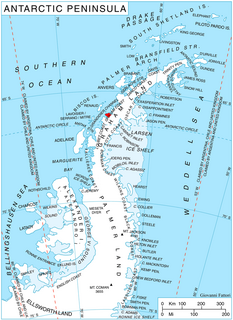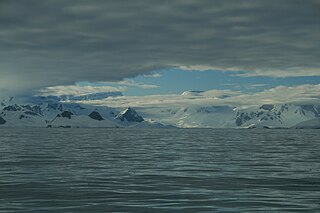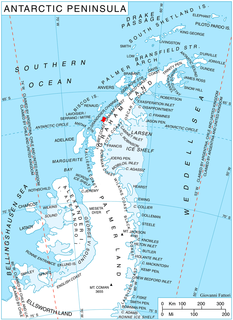The French Antarctic Expedition is any of several French expeditions in Antarctica.

Mount Zdarsky is a mountain rising at the east side of Simler Snowfield on Velingrad Peninsula, between Barilari and Holtedahl Bays on the west coast of Graham Land, Antarctica. First charted and named "Mont Garcia" by the French Antarctic Expedition under Jean-Baptiste Charcot, 1908–10, presumably in association with his nearby "Cap Garcia".

Syrezol Rocks is a small group of rocks lying 1 mile (1.6 km) west of Martins Head at the east side of the entrance to Admiralty Bay, King George Island, in the South Shetland Islands. In 1908-10, the Fourth French Antarctic Expedition under Jean-Baptiste Charcot assigned the name "Cap Syrezol" to a feature between what is now Martins Head and Chabrier Rock. Since there is no distinctive point or cape in this position, the name has been applied to these rocks in order to preserve Charcot's naming in the area in which it was originally given.

Acosta Glacier is a glacier about 2 miles (3 km) long flowing north from Thurston Island just east of Dyer Point in Antarctica. It was named by the Advisory Committee on Antarctic Names (US-ACAN) after Alex V. Acosta of the United States Geological Survey (USGS) in Flagstaff, Arizona. He is a computer and graphic specialist, and was part of the USGS team that compiled the 1:5,000,000-scale Advanced Very High Resolution Radiometer satellite image maps of Antarctica and the 1:250,000-scale Landsat image maps of the Siple Coast area in the 1990s.

Barilari Bay is a bay 12 nautical miles (22 km) long and 6 nautical miles (11 km) wide, between Cape Garcia and Loqui Point on the west coast of Graham Land. The glaciers Birley, Lawrie, Weir and Bilgeri feed the bay.

Beascochea Bay is a bay, 10 nautical miles (19 km) long and 5 nautical miles (9 km) wide, indenting the Graham Coast of Graham Land, Antarctica, between Kiev Peninsula and Barison Peninsula, and entered south of Cape Perez. The glaciers Lever, Funk, Cadman, Talev and Butamya feed the bay.

Cape Bellue is a headland on the north side of the entrance to Darbel Bay, which forms the west extremity of Stresher Peninsula on the west coast of Graham Land, Antarctica. It separates Graham Coast to the northeast from Loubet Coast to the southwest. Discovered by the French Antarctic Expedition, 1908–10, under Charcot, and named by him for Admiral Bellue, Superintendent of the Dockyard at Cherbourg, France.

Birley Glacier is a glacier, at least 10 nautical miles (19 km) long, flowing west into the eastern extremity of Barilari Bay north of Vardun Point, on the west coast of Graham Land. First seen and roughly surveyed in 1909 by the French Antarctic Expedition under Jean-Baptiste Charcot, it was re-surveyed in 1935–36 by the British Graham Land Expedition (BGLE) under John Rymill, and later named for Kenneth P. Birley, who contributed toward the cost of the BGLE, 1934–37.

Bussey Glacier is a glacier flowing west from Mount Peary to the head of Waddington Bay on Kiev Peninsula on the west coast of Graham Land. It was first charted by the French Antarctic Expedition under Jean-Baptiste Charcot, 1908–10, and named by the UK Antarctic Place-Names Committee in 1959 for Group Captain John Bussey of the Directorate of Overseas Surveys.

Weir Glacier is a glacier 8 nautical miles (15 km) long, flowing north into the south part of Barilari Bay between Prestoy Point and Byaga Point, on the west coast of Graham Land. First sighted and roughly charted in 1909 by the French Antarctic Expedition under Charcot. It was surveyed in 1935-36 by the British Graham Land Expedition (BGLE) under Rymill and later named for William D. Weir, 1st Viscount Weir of Eastwood, and his son, the Hon. James K. Weir, who contributed toward the cost of the BGLE, 1934-37.

Darbel Bay is a bay 25 nautical miles (50 km) wide, indenting the west coast of Graham Land between Stresher Peninsula and Pernik Peninsula. Entered southwest of Cape Bellue and northeast of Cape Rey. The glaciers Widmark Ice Piedmont, Cardell, Erskine, Hopkins, Drummond, Widdowson, McCance, Solun and Škorpil feed the bay.

Trooz Glacier is an Antarctic glacier. Situated on the Kiev Peninsula in Graham Land, 1.5 nautical miles (2.8 km) wide at its mouth and some 15 nautical miles (28 km) long, it flows west into the north part of Collins Bay. It was Discovered by the French Antarctic Expedition, 1908-10 and Named for J. de Trooz, Belgian Minister of the Interior and Public Instruction, who was instrumental in procuring funds for the publication of the scientific results of the Belgian Antarctic Expedition, 1897-99. This application was suggested by the Advisory Committee on Antarctic Names (US-ACAN) because of duplication of the name Trooz for what is now known as Cape Perez.

Cape Pérez is a prominent cape between Collins Bay and Beascochea Bay on Kiev Peninsula, the west coast of Graham Land. It was discovered by the Belgian Antarctic Expedition, 1897–99, under Adrien de Gerlache, but apparently not named by them until about 1904, when in working up their scientific reports they gave it the name Trooz. In the meantime, Charcot's French Antarctic Expedition, 1903–05, left for the Antarctic and in November 1904 resighted the same cape, to which they gave the name Trois Pérez, for the brothers Fernando, Leopoldo and Manuel Pérez of Buenos Aires. Maurice Bongrain in his report of 1914 acknowledges the Belgian name Trooz for this cape. However, the Advisory Committee on Antarctic Names has retained the Charcot name because of wider usage, and has given the name Trooz to the large glacier 5 nautical miles (9.3 km) northeast of Cape Pérez.

Duyvis Point is the point forming the southeast side of the entrance to Urovene Cove situated 11 nautical miles (20 km) south-southeast of Cape Garcia and 2.65 km southeast of Laskar Point, on the southwest coast of Felipe Solo (Obligado) Peninsula, Graham Land in Antarctica. It was first roughly charted by the British Graham Land Expedition under John Rymill, 1934–37. It was mapped more accurately by the Falkland Islands Dependencies Survey from photos taken by Hunting Aerosurveys Ltd in 1956–57, and was named by the UK Antarctic Place-Names Committee for F. Donker Duyvis, a Dutch documentalist who was Secretary of the International Federation for Documentation.
Monflier Point is a point which marks the southwest end of Rabot Island in the Biscoe Islands of Antarctica. It was first charted and named by the Fourth French Antarctic Expedition, 1908–10, under Jean-Baptiste Charcot.

Cape Garcia is a cape at the north side of the entrance to Barilari Bay, forming the north extremity of Felipe Solo (Obligado) Peninsula on the west coast of Graham Land, Antarctica. The cape was discovered and named "Cap Loqui" by the French Antarctic Expedition, 1903–05, under Jean-Baptiste Charcot. At the same time Charcot named the south entrance point to the bay "Cap Garcia," after Rear Admiral Garcia of the Argentine Navy. The maps of Charcot's French Antarctic Expedition, 1908–10, showed "Cap Garcia" as the north cape of Barilari Bay and the name has since become established for this feature. Charcot did not use the name "Cap Loqui" on the maps of his second expedition but, for the sake of historical continuity, the name Loqui Point has been accepted for the south entrance point.

McCance Glacier is the 30-km long and 5 km wide glacier draining the Hutchison Hill area on the west slopes of Avery Plateau on Loubet Coast in Graham Land, Antarctica. It flows north-northwestwards along the west side of Osikovo Ridge, Kladnitsa Peak and Rubner Peak and enters Darbel Bay.

Schokalsky Bay is the easternmost bay of Alexander Island, Antarctica, 9 nautical miles (17 km) wide at its entrance and indenting 6 nautical miles (11 km) lying between Mount Calais and Cape Brown along the east coast of Alexander Island whilst adjacent to the George VI Ice Shelf in George VI Sound. Hampton Glacier discharges tremendous amounts of ice into the head of Schokalsky Bay at a steep gradient causing the ice there to be extremely broken and irregular, and discourages use of this bay and glacier as an inland sledging route onto northeast Alexander Island. The bay was first sighted from a distance in 1909 and roughly charted by the French Antarctic Expedition under Charcot who, thinking it to be a strait, gave the name "Detroit Schokalsky" after Yuliy M. Shokal'skiy, Russian geographer, meteorologist and oceanographer. Charcot followed the spelling Schokalsky used by the man himself when writing in Roman script. The coast in this vicinity was photographed from the air and this bay roughly charted in 1937 by the British Graham Land Expedition, but Charcot's "Detroit Schokalsky" was not identified. Surveys by Falkland Islands Dependencies Survey in 1948 identified this bay as the feature originally named by Charcot.

Sphinx Island is an island 2 nautical miles (3.7 km) long and 1 nautical mile (1.9 km) wide, having a bare rocky summit with vertical faces on all four sides, lying in the entrance to Barilari Bay north of Loqui Point on Velingrad Peninsula, Graham Land in Antarctica. Discovered and named by the British Graham Land Expedition (BGLE), 1934–37, under Rymill.

Lind Glacier is a glacier flowing west from Alencar Peak into the southern part of Collins Bay, on the west coast of Kiev Peninsula in Graham Land, Antarctica. It was first charted by the Fourth French Antarctic Expedition under Jean-Baptiste Charcot, 1908–10, and was named by the UK Antarctic Place-Names Committee in 1959 for James Lind, the Scottish "founder of modern naval hygiene," who was the first to publish a convincing account of experimental work establishing the dietary cause and cure of scurvy, in 1755.















